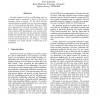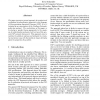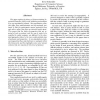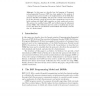FCS
2006
14 years 8 months ago
2006
: We introduce an extended model for view-centric reasoning, EVCR, that provides more nsive and flexible abstractions for representing actual concurrency. The theory of Communicati...
WOTUG
2008
14 years 8 months ago
2008
Writing concurrent programs in languages that lack explicit support for concurrency can often be awkward and difficult. Haskell's monads provide a way to explicitly specify se...
WOTUG
2008
14 years 8 months ago
2008
Abstract. Communicating Sequential Processes (CSP) was developed around a formal algebra of processes and a semantics based on traces (and failures and divergences). A trace is a r...
MPC
1989
Springer
14 years 11 months ago
1989
Springer
A scheme is presented which transforms systolic programs with a two-dimensionalstructure to one dimension. The elementary steps of the transformation are justified by theorems in ...
SP
1996
IEEE
14 years 11 months ago
1996
IEEE
Security properties such as con dentiality and authenticity may be considered in terms of the ow of messages within a network. To the extent that this characterisation is justi ed...
CSFW
1997
IEEE
14 years 11 months ago
1997
IEEE
This paper presents a general approach for analysis and veri cation of authentication properties in the language of Communicating Sequential Processes (CSP). It is illustrated by ...
CSFW
1998
IEEE
14 years 11 months ago
1998
IEEE
This paper applies the theory of Communicating Sequential Processes (CSP) to the modelling and analysis of a non-repudiation protocol. Non-repudiation protocols di er from authent...
IPPS
1999
IEEE
14 years 11 months ago
1999
IEEE
Abstract. In this paper we describe how the language of Communicating Sequential Processes CSP has been applied to the analysis of a transport layer protocol used in the implementa...
CCECE
2006
IEEE
15 years 1 months ago
2006
IEEE
To help programmers of high-performance computing (HPC) systems avoid communication-related errors, we employ a formal process algebra, Communicating Sequential Processes (CSP), w...
B
2007
Springer
15 years 1 months ago
2007
Springer
Abstract. CSP B is an integration of the process algebra Communicating Sequential Processes (CSP), and the B-Method, which enables consistent controllers to be written for B machin...




